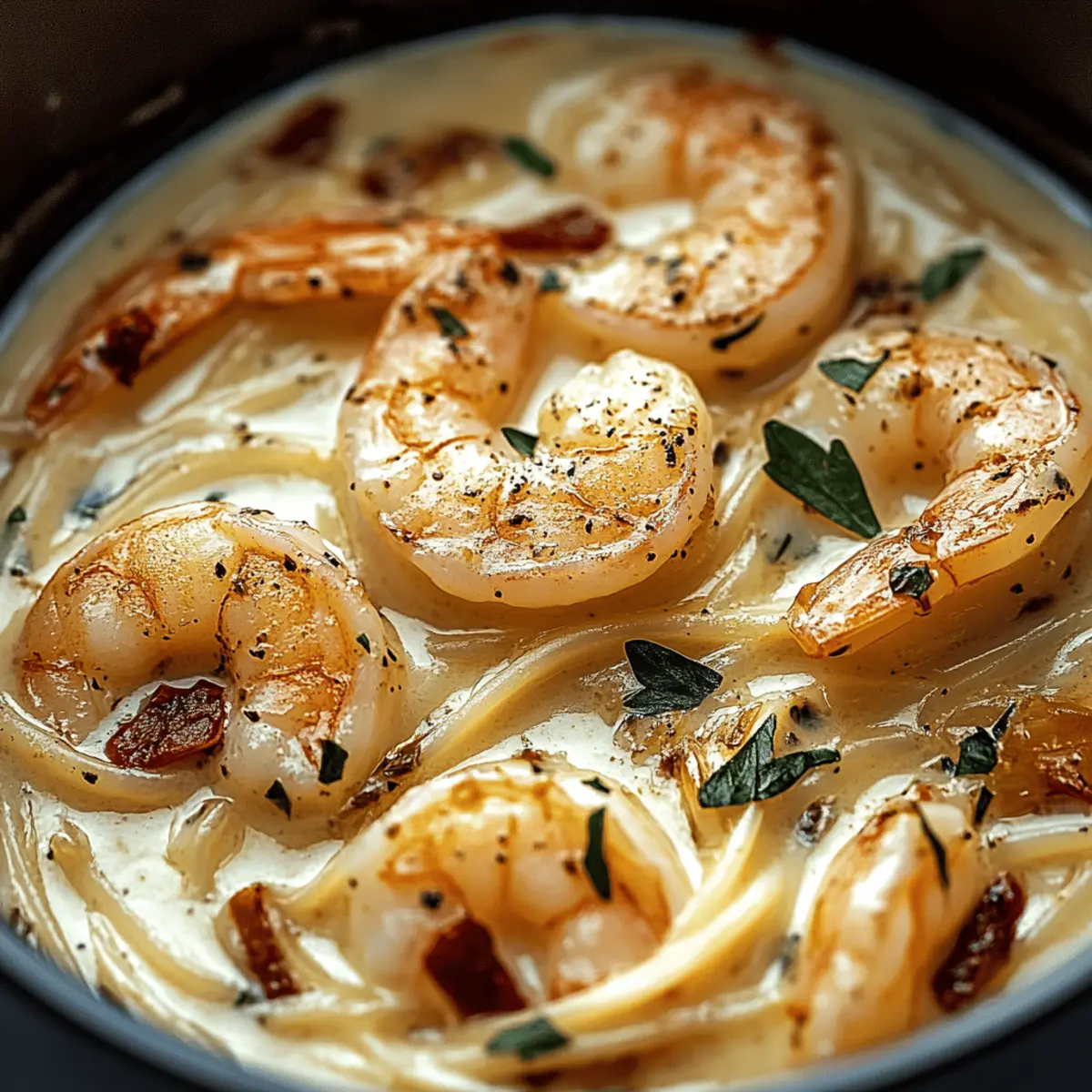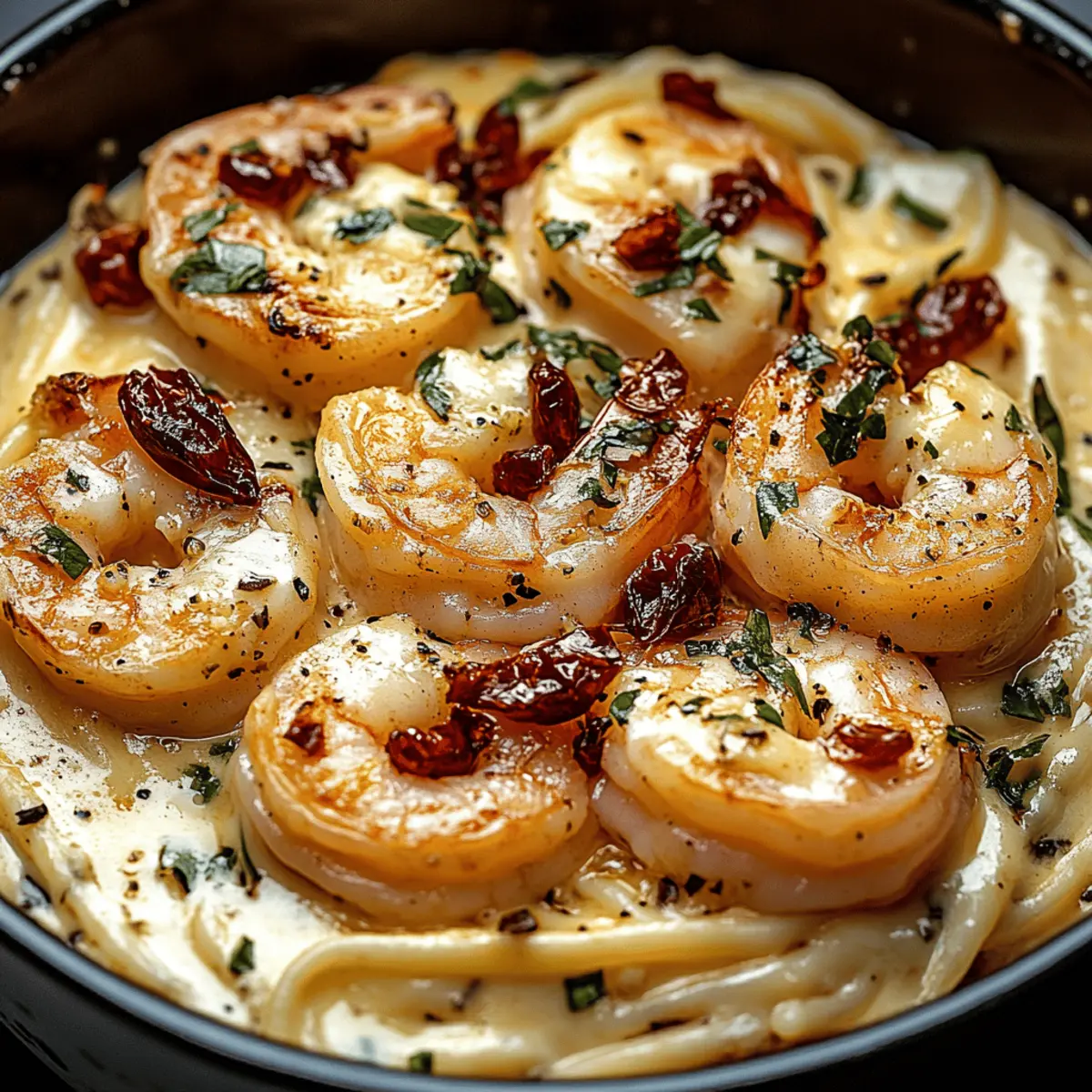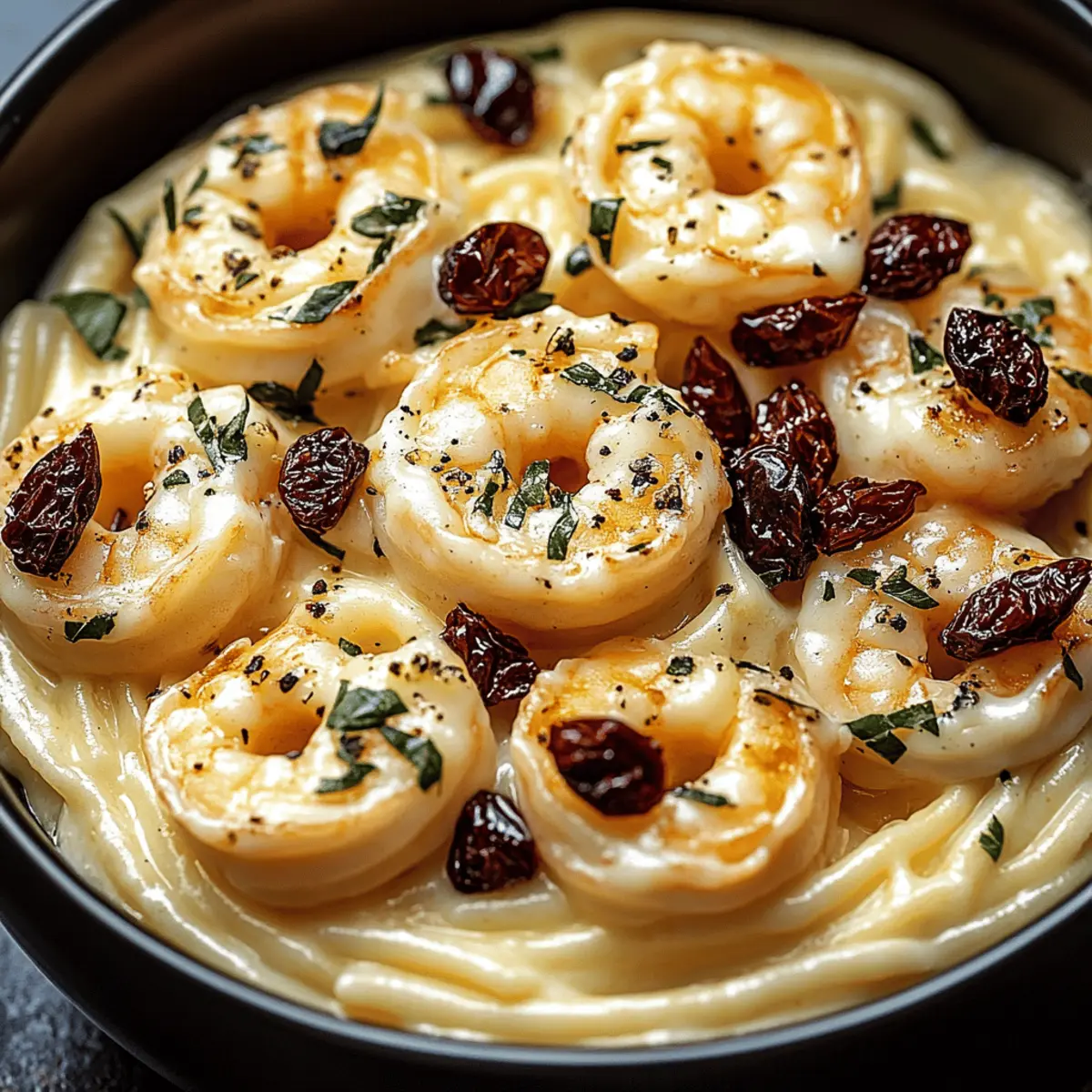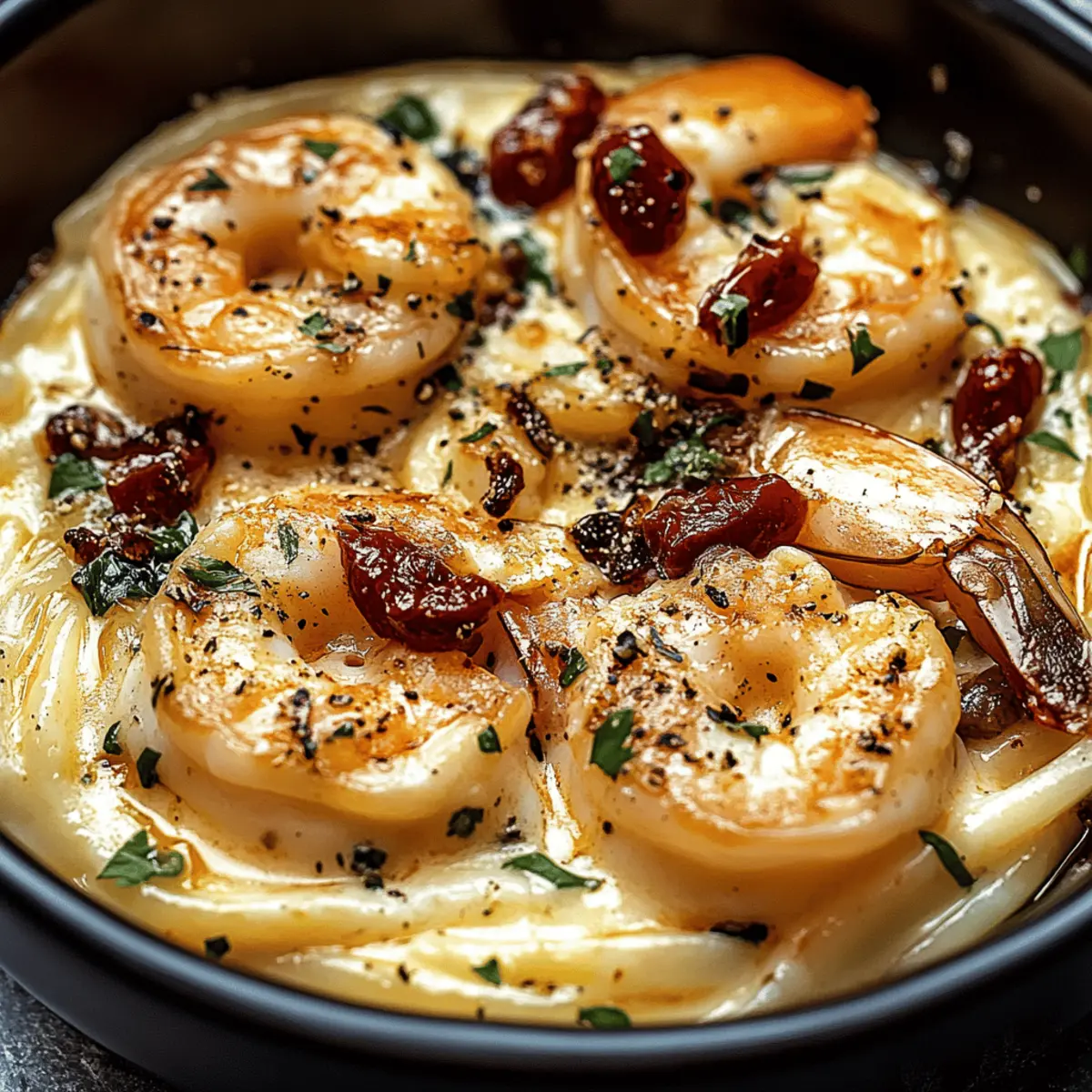As I stirred the vibrant mixture of sun-dried tomatoes and creamy mascarpone in the skillet, a wave of nostalgia hit me—reminding me of sunny Mediterranean afternoons. This Shrimp Pasta with Sun-Dried Tomatoes and Mascarpone is the perfect escape from mundane meals, transforming your dinner table into a delightful experience. You’ll be amazed at how quick the preparation is; in just 25 minutes, you can enjoy a restaurant-worthy dish that’s guaranteed to impress. Plus, it's a fantastic way to elevate your pasta game while ensuring it’s packed with protein and wholesome ingredients. So, are you ready to discover your new favorite weeknight dinner? Let’s dive into this scrumptious recipe!

Why is this Shrimp Pasta special?
Quick and Easy: In just 25 minutes, you can whip up this restaurant-quality dish, perfect for busy weeknights.
Flavor Explosion: The combination of sun-dried tomatoes and mascarpone creates a creamy, luscious sauce that will make your taste buds dance.
Protein-Packed: With 30 grams of protein per serving, this pasta not only satisfies your cravings but also keeps you nourished.
Versatile and Vibrant: Pair it with a bright lemon vinaigrette salad or garlic bread for a complete meal—the possibilities are endless!
Crowd-Pleaser: Impress family and friends with a dish that balances decadence and simplicity, making it ideal for any gathering.
Shrimp Pasta with Sun-Dried Tomatoes Ingredients
• Discover the essential ingredients for this delightful meal!
For the Pasta
- 12 oz pasta – Choose linguine, fettuccine, or spaghetti to suit your preference.
For the Sauce
- 2 tablespoon olive oil – This helps create a rich base for the sauce.
- 3 cloves garlic, minced – Fresh garlic adds aromatic depth to the dish.
- ½ cup sun-dried tomatoes, chopped – Key to achieving that burst of flavor in your Shrimp Pasta.
- ¼ cup white wine or broth – Used to deglaze the pan and enhance the overall taste.
For the Main Component
- 10 oz shrimp, peeled and deveined – Provides a delicious protein boost and quick cooking time.
- ½ cup mascarpone cheese – This creamy cheese makes the sauce luxuriously smooth.
To Finish
- Salt (to taste) – Elevates the flavors of the dish.
- Pepper (to taste) – Adds a touch of spice to the overall profile.
- Fresh basil leaves or finely chopped parsley – Perfect for garnishing and adding a fresh note.
- Parmesan cheese – Serve on the side for those who desire extra cheesy goodness.
- Lemon wedges – A zesty touch to complement the flavors when serving.
Step‑by‑Step Instructions for Shrimp Pasta with Sun-Dried Tomatoes Mascarpone
Step 1: Cook the Pasta
Begin by bringing a large pot of salted water to a boil over high heat. Once boiling, add 12 ounces of your chosen pasta—linguine, fettuccine, or spaghetti. Cook according to the package instructions until al dente, typically around 8-10 minutes. Remember to reserve a cup of the pasta water before draining the pasta in a colander. Set the drained pasta aside while preparing the sauce.
Step 2: Prepare the Flavors
In a large skillet, heat 2 tablespoons of olive oil over medium heat until shimmering. Add 3 cloves of minced garlic to the skillet and sauté for about 30 seconds or until fragrant, taking care not to let it brown. Introduce ½ cup of chopped sun-dried tomatoes to the skillet and cook for an additional 2–3 minutes, until they soften and infuse the oil with their rich flavors.
Step 3: Cook the Shrimp
Add 10 ounces of peeled and deveined shrimp to the skillet, spreading them in a single layer. Sauté for about 2-3 minutes on each side or until the shrimp turn pink and opaque, signaling they’re fully cooked. Season with salt and pepper to elevate the dish's flavors. Keep an eye on them—they cook quickly and should not be overdone.
Step 4: Deglaze the Pan
Pour in ¼ cup of white wine or broth to deglaze the skillet, scraping up any browned bits stuck to the bottom. Let the mixture come to a gentle simmer for about 2 minutes to reduce slightly. This step enhances the overall flavor of your Shrimp Pasta with Sun-Dried Tomatoes Mascarpone, adding depth to the sauce that will envelop the pasta.
Step 5: Create the Creamy Sauce
Lower the heat and mix in ½ cup of mascarpone cheese, stirring until it melts and creates a smooth, creamy sauce. If the sauce appears too thick, reach for the reserved pasta water and add it gradually until you achieve your desired consistency. This creamy mixture beautifully combines with the sun-dried tomatoes and shrimp.
Step 6: Combine with Pasta
Carefully add the cooked pasta to the skillet, gently tossing it in the creamy mascarpone and shrimp mixture. Heat everything together for about 1-2 minutes, allowing the pasta to absorb the delicious flavors. This final step ensures the pasta is well-coated and thoroughly warmed, ready to be served.
Step 7: Serve the Dish
Once everything is well combined, turn off the heat and serve your Shrimp Pasta with Sun-Dried Tomatoes Mascarpone immediately. Garnish with fresh basil leaves or parsley and a sprinkle of Parmesan cheese for added flavor. Accompany each plate with lemon wedges for a zesty finish, enhancing the dish's delightful complexity.

Expert Tips for Shrimp Pasta
Choosing the Right Pasta: Ensure you select a type you love, like linguine or spaghetti, for optimal texture with the shrimp pasta.
Pasta Water Magic: Always reserve a cup of pasta water! It acts as a thickener and helps achieve the perfect sauce consistency for your Shrimp Pasta with Sun-Dried Tomatoes Mascarpone.
Perfect Shrimp Cooking: Avoid overcooking your shrimp. Cook just until they turn pink and opaque, approximately 2-3 minutes per side, for tender results.
Balancing Flavors: Don’t skip the deglazing step with white wine or broth. Scraping the bits from the bottom enhances the flavors and depth of your sauce.
Creamy Consistency Check: If your sauce appears too thick, gradually add reserved pasta water until it reaches the desired creaminess, ensuring a luscious coating over the pasta.
Storage Tips for Shrimp Pasta with Sun-Dried Tomatoes Mascarpone
Fridge: Refrigerate leftovers in an airtight container for up to 3 days. This ensures the flavors stay intact while keeping the dish safe to enjoy later.
Freezer: For longer storage, this Shrimp Pasta can be frozen for up to 1 month. Use freezer-safe containers, leaving a little space for expansion.
Reheating: When ready to enjoy, reheat gently over low heat, adding a splash of cream or reserved pasta water to restore creaminess and moisture. Enjoy the comforting flavors anew!
Serving: Serve heated with fresh garnishes to revive the dish’s vibrant colors and flavors.
Make Ahead Options
These Shrimp Pasta with Sun-Dried Tomatoes & Mascarpone are perfect for busy weeknights! You can prepare the sun-dried tomato mixture and cook the shrimp up to 24 hours in advance, then refrigerate them in an airtight container. This ensures the flavors marinate beautifully, enhancing your dish. You can also cook the pasta and toss it with a little olive oil to prevent it from sticking. When you're ready to serve, simply reheat the shrimp and sauce over low heat, combine with the pasta, and add in the mascarpone cheese until smooth. You'll have a fresh, delicious meal ready in no time, just as comforting and delightful as if you made it that evening!
Shrimp Pasta with Sun-Dried Tomatoes Variations
Customize your shrimp pasta to match your mood and ingredients on hand for a dish that's uniquely yours!
- Gluten-Free: Substitute regular pasta with gluten-free options like brown rice or quinoa pasta for a delightful twist.
- Vegetarian Delight:Skip the shrimp and use mushrooms or zucchini for a filling vegetarian option that stays deliciously creamy.
- Creamy Vegan: Use cashew cream or a plant-based cream cheese in place of mascarpone for a rich, dairy-free experience.
- Spicy Kick: Add a pinch of red pepper flakes or a diced jalapeño while sautéing for an extra layer of heat.
- Herb Infusion: Mix in fresh herbs such as dill or tarragon to enhance aromatic dimensions in your dish—think vibrant flavor profiles!
- Lemon Zest Boost: Grate lemon zest into the sauce for a bright, citrusy note that perfectly complements the shrimp.
- Nutty Flavor: Toss in some toasted pine nuts or walnuts when plating for an unexpected crunch and earthy flavor.
- Cheese Lovers’ Twist: Try switching out Parmesan for a smoked cheese sprinkle, adding a beautiful depth to your sauce.
What to Serve with Shrimp Pasta with Sun-Dried Tomatoes & Mascarpone
Elevate your dining experience with delightful sides that complement the creamy goodness of this shrimp pasta.
- Crisp Green Salad: A light salad with mixed greens and lemon vinaigrette adds a refreshing contrast to the rich pasta.
- Garlic Bread: The aroma of warm, buttery garlic bread is irresistible and perfect for soaking up the creamy sauce.
- Roasted Asparagus: Tender roasted asparagus offers a vibrant color and a satisfying crunch, enhancing the meal's textures.
- Grilled Vegetables: Seasonal grilled veggies, like zucchini and bell peppers, bring out the fresh flavors while adding a smoky depth.
- Moscato Wine: A chilled glass of sweet Moscato perfectly balances the savory and creamy notes of the shrimp pasta.
- Tiramisu: End your meal on a sweet note with a rich tiramisu, its coffee flavors elegantly complementing the pasta's creamy indulgence.

Shrimp Pasta with Sun-Dried Tomatoes & Mascarpone Recipe FAQs
What type of pasta works best for this dish?
Absolutely! You can use linguine, fettuccine, or spaghetti for this Shrimp Pasta with Sun-Dried Tomatoes Mascarpone. Each type brings its unique texture, so choose your favorite. Linguine is lovely for a slightly flatter noodle that holds onto the creamy sauce beautifully.
How should I store leftover Shrimp Pasta?
Refrigerate leftovers in an airtight container for up to 3 days. Make sure it’s cooled down before sealing to maintain freshness. When you’re ready to enjoy it again, just reheat gently over low heat, adding a splash of cream or reserved pasta water to keep it creamy.
Can I freeze the Shrimp Pasta?
Yes, you can! For longer storage, this dish can be frozen for up to 1 month. Use freezer-safe containers and leave a little space at the top, as it may expand during freezing. When ready to eat, thaw it in the refrigerator overnight before reheating.
What if my sauce is too thick?
If your creamy sauce turns out too thick, don’t worry! Gradually add the reserved pasta water, mixing well until you reach the desired consistency. This trick not only helps with thickness but also enhances the flavor. I recommend adding in small increments, tasting along the way!
Are there any dietary considerations I should be aware of?
Certainly! This recipe contains shrimp, which is a common allergen, so be mindful if you’re cooking for someone with shellfish allergies. Additionally, mascarpone cheese includes dairy, so those with lactose intolerance might want to opt for a non-dairy cream alternative. Always feel free to tailor the recipe to accommodate dietary restrictions—after all, cooking should be inclusive and enjoyable for everyone!

Indulgent Shrimp Pasta with Sun-Dried Tomatoes Mascarpone
Ingredients
Equipment
Method
- Begin by bringing a large pot of salted water to a boil over high heat. Once boiling, add 12 ounces of your chosen pasta and cook according to package instructions until al dente, about 8-10 minutes. Reserve 1 cup of pasta water, then drain the pasta.
- In a large skillet, heat 2 tablespoons of olive oil over medium heat. Add 3 cloves of minced garlic and sauté until fragrant, about 30 seconds. Add ½ cup of chopped sun-dried tomatoes and cook for 2-3 minutes.
- Add 10 ounces of shrimp to the skillet and cook for 2-3 minutes on each side until pink and opaque. Season with salt and pepper.
- Pour in ¼ cup of white wine or broth to deglaze the skillet, scraping any browned bits. Let it simmer for about 2 minutes.
- Lower the heat, mix in ½ cup of mascarpone cheese, stirring until melted and smooth. Gradually add reserved pasta water until the desired consistency is achieved.
- Add the cooked pasta to the skillet, tossing gently to coat in the sauce. Heat everything for 1-2 minutes.
- Serve immediately, garnishing with fresh basil or parsley, a sprinkle of Parmesan cheese, and lemon wedges.





Leave a Reply